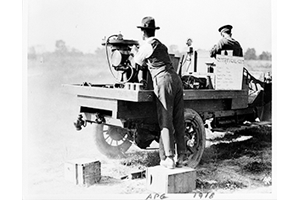100 Years of Excellence: The ATC Story
Excerpted from an article by Lauren Nelson

Testing a smooth bore centrifugal gun at Aberdeen
Proving Ground, circa 1918. The gun proved to be highly inaccurate.
The U.S. Army Test and Evaluation Command’s (ATEC) ATC is a premier test facility, with a reputation founded on the work ethic and dedication of the people who work here. Our advances in technology, ranging from automotive and weapon development to breakthroughs in the test process itself, demonstrate the capabilities of this Test Center.
ATC’s inception was a result of the United States’ engagement in World War I. Before 1917, all of the Army’s proof testing was done at Sandy Hook Proving Ground, New Jersey. As wartime work and technology advanced, Sandy Hook’s location and size proved inadequate for the Army’s needs. COL Colden L. Ruggles guided the search for a new location, a quest that would lead him to the northern Chesapeake Bay. Ruggles first explored Kent Island as a possibility, but he met with great opposition from the local inhabitants, the residents of Annapolis, and the state of Maryland.
The Aberdeen area was suggested to Ruggles by a fellow West Point graduate, the retired Major Edward V. Stockham. The fertile farmland on the northwestern shore of the Bay met the Army’s needs. The location was only two hours from Washington, DC and Philadelphia, important industrial centers. The Pennsylvania Railroad was easily accessible, assuring easy transport of materiel and personnel. Aberdeen’s weather was reported to be favorable year-round, and the area was large and remote enough to permit uninterrupted work without undue danger or disturbance to nearby communities.
Following two Presidential Proclamations, one in October and one in December 1917, as well as an Act of Congress, Aberdeen Proving Ground (APG) came into the possession of the U.S. Army. Construction of the proving ground began in December 1917, and the Proof Department, ATC’s predecessor, began testing on January 2, 1918.
During those first days, ammunition and gun testing were the principal functions of APG. Development work was also conducted and chiefly consisted of experiments with various types of fuses and igniters. Approximately 425,000 rounds of all different calibers were fired at APG in 1918 (about five times more than the rounds fired during the Franco-Prussian War, which used more ammunition than any in previous history). At the height of operations during World War I, APG employed about 7,500 people: 5,000 military personnel and 2,500 civilians. The first year of testing at APG produced great advances in test technology as well as weapons systems. The Aberdeen Chronograph, a velocity-measuring instrument, was developed to improve the testing of projectiles and guns. Rocket Science also developed greatly during this time. Dr. Robert Goddard, the famous physicist and inventor of the liquid-fueled rocket, conducted many tests at APG in 1918. Along with his colleague, Dr. Clarence Hickman, Goddard created our first air defense rocket prototype. Goddard’s research at APG contributed to the later development of the bazooka, the high profile rocket launcher of World War II.
You are now leaving www.atc.army.mil and entering another site. You will automatically be forwarded to the target page within five seconds.
